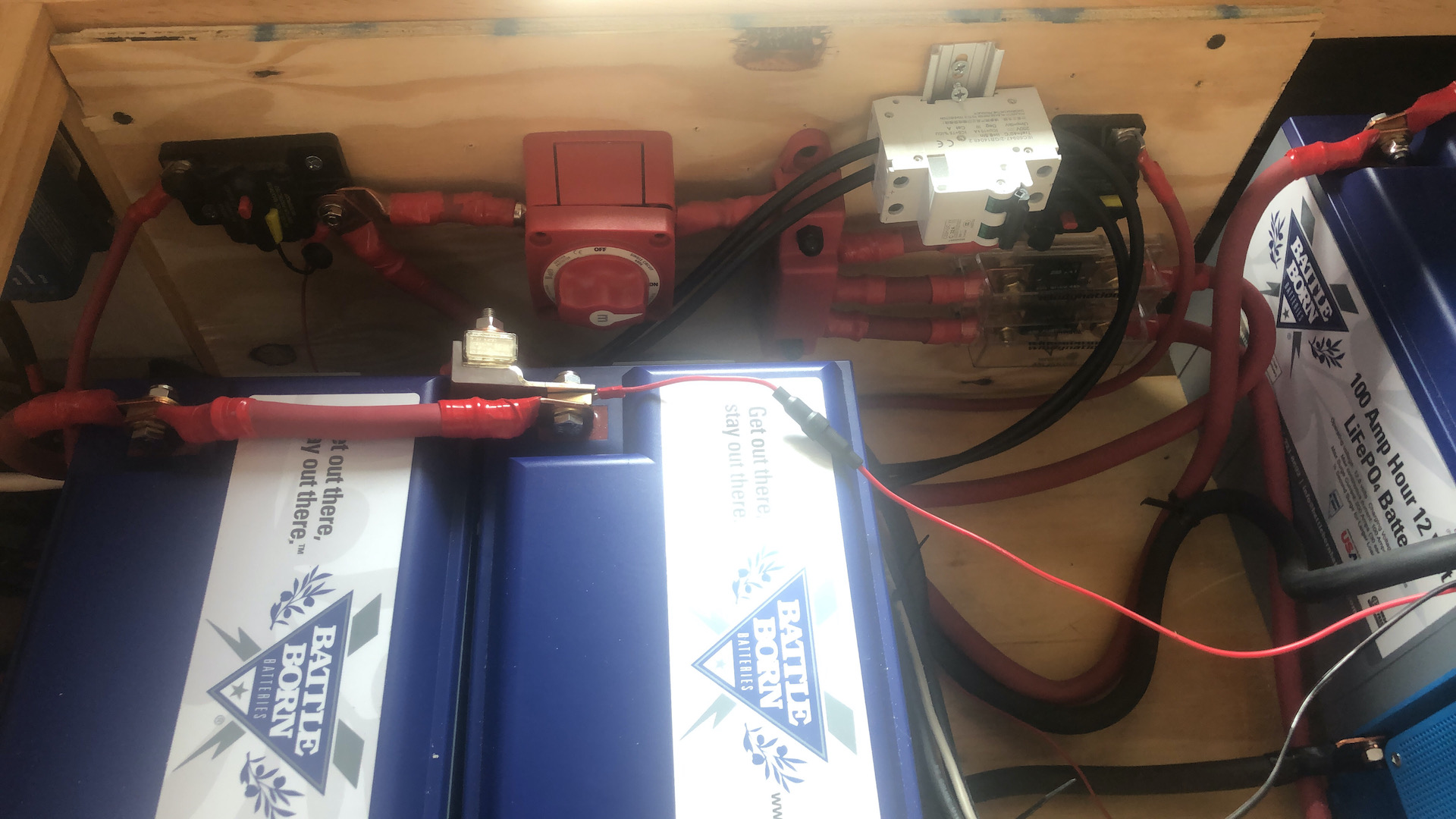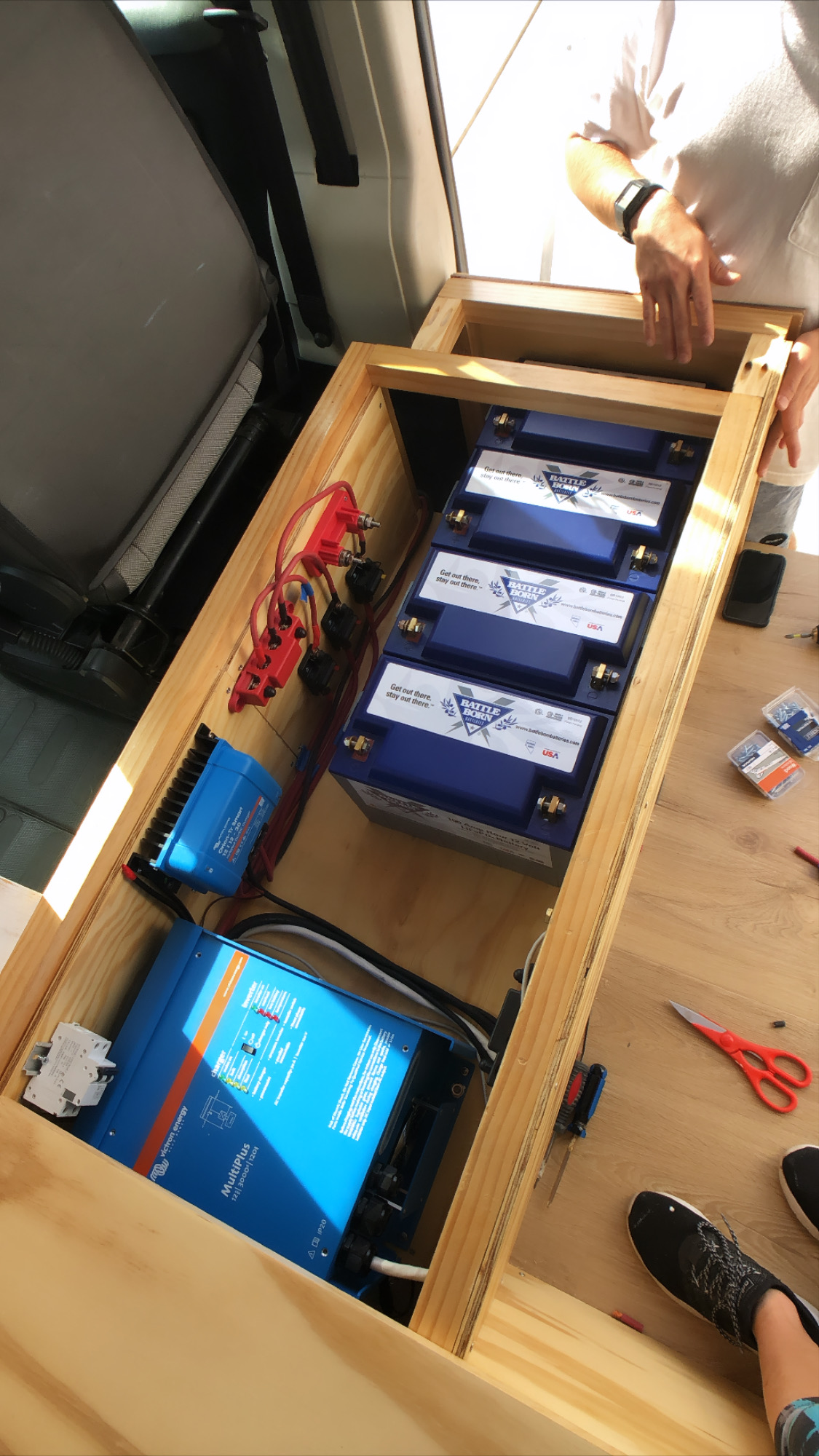I have a multiplus 12/3000/120 and a roof top Dometic A/C that will trip my 300A breaker when the compressor would want to start. I’ve installed an “easy start” it helped when connected to a 15A shore power but if I try running only the inverter it will trip the breaker. I have 1 2/0 wire going into the multi + and - I don’t know if I should increase the breaker? Is my wire safe? Is my multi safe if I go to a 400A fuse? Thanks.
- Home
- Anonymous
- Sign in
- Create
- Spaces
- Grafana
- Node-Red
- Unsupported topics
- Questions & Answers
- Modifications
- Communauté francophone
- Deutschsprachiger Bereich
- Preguntas en Español
- Explore
- Topics
- Questions
- Ideas
- Articles
- Badges
question
Hi @Mariorda91
Recommended fuse size is 400A, what type of fuse are you using?
We have run several Dometic Air-conditioners off 12V. The typical peak current on startup was between 400 and 457A for around 1-2 seconds as seen on the scope. A 400A fuse will sustain that. The bigger current draw is not on initial startup but on re-start after they are very hot. We have no difficulty with the Multiplus 12/3000 and (non Victron) Lithium batteries that are capable of a 500A minimum surge. The BMS in the Lithium will knock out the system faster than the fuse if they cant sustain this surge.
Hi, @Daniël Boekel (Victron Energy Staff)
I am currently using a 300A breaker. If I replace this 300A breaker (which is from the batteries to the inverter) does this also mean I need to change the fuse from the batteries? It’s currently on a 300A battery terminal from blue sea.
Hi @Mariorda91
Please consult an electrician to check your system (components, wiring, connections) to make sure it is up to the task.
If it were me, I would get rid of the 300A breaker and use a 400A fuse. I would also move up to larger size cables from battery to inverter.
Most breakers larger than 250A are not DC rated and don’t have a good trip curve. If your breaker isn’t DC rated for what you are using it for, it is a big time hazard.
Your inverter is definitely capable of starting and running that AC unit. But I don’t think your cabling and fusing are up to par yet.
Hi, @solardude
I am currently using 2/0 for the whole system. I have some extra 2/0. Do you think if I add another 2/0 + and - with a 400A fuse (that will be a new 400A fuse and another 400A fuse that will replace the 300A breaker that's currently in place) so 2 positive and 2 negative 2/0 cable going into the inverter/charger and each with a 400A fuse in between will suffice? or should I rather get 4/0 to go in the inverter/charger with a 400A fuse in between? Also, what about the 300A battery terminal fuse I currently have in place? should I bump that to 400A as well?
I really appreciate taking the time to help me figure this out.
I’m a bit confused on what you are asking. But I’ll try to make some recommendations.
Choice of 2X 2/0 or 1X 4/0 cables...both are fine. If you already have 1X 2/0 cable, and have extra cable and terminals for 2/0, just double it up. Otherwise use 1X 4/0 cable.
You don’t need a fuse for each cable if you go 2X 2/0.
Connect 2X 2/0 positive cables at battery. Keep those cables short, 12” if possible. Connect both to one side of a 400A fuse holder. Connect 2 more 2/0 cables on the other side (output) of the fuse, those go to the inverter.
Now, 2X 2/0 negative cables go directly from battery to inverter.
This is all you need for the DC side of the inverter. If you have other DC loads that are not inverted, you need a separate cable for those. What I do, is ouput 4/0 from the battery to the fuse, 4/0 from the fuse to a 4 terminal bus bar, then from there you have a clean way to connect your 2X 2/0 cables, as well as another DC load cable.
I do the same on the negative side, minus the fuse of course
The Victron diagrams on their site are pretty good. If you have any more questions please ask. Glad to help.
@solardude I understand this very good! thanks man. I do have a few other questions. So I have 4x 100AmpH BattleBorn Lithium Batteries in parallel so 400AmpH. Questions:
1) the parallel connections are made with 2/0 cable, should I replace it with 4/0?
2) The battery terminal fuse is a 300A, should I also replace this for a 400A fuse?
Thanks,
Parallel batteries makes is a bit more wiring, but doesn’t change the overall design too much.
The 400A fuse I outlined for you is the only fuse you need.
Simple Breakdown:
Run as short as possible from each battery positive to a 4 terminal bus bar. Then short as possible 1X 4/0 or 2X 2/0 to a 400A fuse. Then to another 4 terminal bus bar. Then 2X 2/0 or 1X 4/0 to inverter.
For negative side, copy exactly minus the fuse. You only need 1 of the 4 terminal bus bars on the negative side.
The fuse protects everything downstream. The 2nd bus bar is now where you connect all components, ie, inverter, solar chargers, external battery chargers, DC fuse panel, etc.
Hmm, I got somewhat confused! I've attached some images of my setup. As you can see, from the last battery positive wire, I go into the output of a 60A breaker (that's for my solar) and from there I go with a 2/0 cable to a kill switch, a question on this:

- should I move this final positive 2/0 cable from the batteries to the master kill switch instead?
If so, should I then, from the kill switch go into the 4 terminal busbar (that I already have), and here I add the 2nd 2/0 positive cable from the already terminal that goes into the new 400A fuse to the inverter?
I hope this makes sense, I can take more pictures if you need me to clarify anything else.
Thanks,
This schematic is very similar to what you are doing. The difference is in how you can fuse it. They show it individually fused to each battery. This is best, but you need to size the fuses to the battery BMS, so probably a 125 or 150A max fuse size. Next best is what I recommended, which is to have a single 400A fuse.
You need to have all of your loads/charge sources coming off one main bus bar.
The master kill can be before or after the main busbar. I actually like it in both places. The more you can isolate components to be able to service them the better.
It is also extremely important that all your parallel cables be exactly the same length. It is even better to buy commercially manufactured cables so they are as close to exact resistance as possible. The downfall of multiple batteries in parallel is that one will end up doing more work than the others, and will slowly kill it. Then they fall like dominos after that.
Took your advice after doing some more research. Below is how my electric,a compartment is looking at the moment. i will be running 4/0 from battery to battery (positive is exiting one side and negative the opposite, to keep them balanced) and from there 400A fuse from batteries to (+) busbar and another 40lA from busbar to inverter/charger. Negatives is the same minus fuses. I will post pictures and results once I have the remaining 4ppA fuse. thanks a lot @solardude
Be careful, those BlueSea M-Series switches are not rated to handle 400A. You might need to switch over to an HD series switch.
It’s rated for 350A continuous and 600A Intermittent which should be fine since the A/C will pull around 350-400A for 1/2 seconds.
Talk to the folks at Micro-Aire there is a firmware update required on the Easy Start when using a 12 volt inverter.
Seems like the unit I purchased (Feb/2020) has the latest firmware. So I a good in that aspect! Thanks for pointing this out! Could be helpful for anyone who purchased the micro-air easy start before Dec/2019.
I run 15k btu AC in RV with easy start and same inverter. I use 400 amp fuse and 4/0 from battery/ Do you have anything else turned on that is using inverter?
No! I was testing only my 13.5 BTU A/C. But the issue at the moment is the 300A fuse I have going from batteries to inverter/charger. I have purchased a 400A fuse to replace this and also replacing the 2/0 cable with 4/0 and trying it again. fingers crossed!
Related Resources
Additional resources still need to be added for this topic
question details
19 People are following this question.
